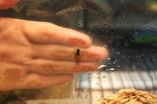(Press-News.org) CHAMPAIGN, Ill. — In September, 2007, the Anaktuvuk River Fire burned more than 1,000 square kilometers of tundra on Alaska's North Slope, doubling the area burned in that region since record keeping began in 1950. A new analysis of sediment cores from the burned area revealed that this was the most destructive tundra fire at that site for at least 5,000 years. Models built on 60 years of climate and fire data found that even moderate increases in warm-season temperatures in the region dramatically increase the likelihood of such fires.
The study was published this October in the Journal of Geophysical Research.
After the Anaktuvuk fire, University of Illinois plant biology professor Feng Sheng Hu sought to answer a simple question: Was this seemingly historic fire an anomaly, or were large fires a regular occurrence in the region?
"If such fires occur every 200 years or every 500 years, it's a natural event," Hu said. "But another possibility is that these are truly unprecedented events caused by, say, greenhouse warming."
On a trip to Alaska in 2008, Hu chartered a helicopter to the region of the Anaktuvuk fire and collected sediment cores from two affected lakes. He and his colleagues analyzed the distribution of charcoal particles in these cores and used established techniques to determine the approximate ages of different sediment layers.
The team found no evidence of a fire of similar scale and intensity in sediments representing roughly 5,000 years at that locale.
The researchers then analyzed 60 years of fire, temperature and precipitation records from the Alaskan tundra to determine whether specific climate conditions prevailed in years with significant tundra fires. They developed a model relating the tundra area burned in Alaska each year to the mean temperature and precipitation in the warmest period of the year: June through September.
This analysis uncovered a striking pattern, Hu said.
"There is a dramatic, nonlinear relationship between climate conditions and tundra fires, and what one may call a tipping point," he said. Once the temperature rises above a mean threshold of 10 degrees Celsius (50 degrees Fahrenheit) in the June-through-September time period, he said, "the tundra is just going to burn more frequently."
For the past 60 years, annual mean temperatures during this warm season have fluctuated between about 6 and 9 degrees Celsius (42.8 to 48.2 degrees Fahrenheit), with temperatures trending upward since 1995. In 2007, the year of the historic fire, the mean temperature was a record 11.1 degrees Celsius, while precipitation and soil moisture dipped to an all-time low.
Higher precipitation, if it occurs, could dampen the effects of higher temperatures, but only to a limited extent, said Philip Higuera, a professor of forest ecology and biogeosciences at the University of Idaho and a co-author on the study.
"As temperature rises, so too does evaporation," he said. "So even if future precipitation increases, it's likely that increased evaporation will result in overall lower moisture availability. This affects plants, but it also makes dead vegetation more flammable and fire prone."
INFORMATION:
The study team also included researchers from the University of Alaska Fairbanks, Neptune and Company, and the University of Washington.
The National Science Foundation and the Joint Fire Science Program supported this study.
Editor's notes: To reach Feng Sheng Hu, call 217-244-2982; e-mail fhu@illinois.edu.
The study, "Tundra Burning in Alaska: Linkages to Climatic Change and Sea Ice Retreat," is available online or from the U. of I. News Bureau.
As Arctic temperatures rise, tundra fires increase, researchers find
2010-11-18
ELSE PRESS RELEASES FROM THIS DATE:
Hearing loss study reveals role of bone hardness in tissue function
2010-11-18
Scientists are reporting the first direct evidence that a subtle change in the physical properties of a tissue can affect its function. The finding has immediate implications for understanding several rare hearing disorders, they said, and ultimately could offer insight into such conditions as osteoporosis, arthritis, cardiovascular disease and cancer.
In their study, the scientists discovered that blocking the function of a particular molecule in the ear bone of mice decreased the hardness of the bone, causing hearing loss. Reactivating the molecule restored the bone's ...
National Zoo and partners first to breed critically endangered tree frog
2010-11-18
As frogs around the world continue to disappear—many killed by a rapidly spreading disease called chytridiomycosis, which attacks the skin cells of amphibians—one critically endangered species has received an encouraging boost. Although the La Loma tree frog, Hyloscirtus colymba, is notoriously difficult to care for in captivity, the Panama Amphibian Rescue and Conservation Project is the first to successfully breed this species.
"We are some of the first researchers to attempt to breed these animals into captivity and we have very little information about how to care ...
Antimatter atoms stored for the first time
2010-11-18
Atoms of antimatter have been trapped and stored for the first time by the ALPHA collaboration, an international team of scientists working at CERN, the European Organization for Nuclear Research near Geneva, Switzerland. Scientists from the U.S. Department of Energy's Lawrence Berkeley National Laboratory and the University of California at Berkeley have made key contributions to the ongoing international effort.
ALPHA stored atoms of antihydrogen, consisting of a single negatively charged antiproton orbited by a single positively charged anti-electron (positron). While ...
Antimatter atoms produced and trapped at CERN
2010-11-18
Geneva, 17 November 2011. The ALPHA experiment at CERN has taken an important step forward in developing techniques to understand one of the Universe's open questions: is there a difference between matter and antimatter? In a paper published in Nature today, the collaboration shows that it has successfully produced and trapped atoms of antihydrogen. This development opens the path to new ways of making detailed measurements of antihydrogen, which will in turn allow scientists to compare matter and antimatter.
Antimatter – or the lack of it – remains one of the biggest ...
Pelletized manure reduces toxic runoff
2010-11-18
Madison WI November 17 2010 – There is considerable amount of uncertainty concerning the environmental impacts that animal hormones have on surface water. Higher concentrations of hormones in waterways have been found to cause physiological and sexual impairment in fish and other aquatic species. However, a study from the University of Delaware that examined estrogen concentrations runoff from agricultural fields fertilized with chicken manure found that it is as much about the application of the manure as it is about the measurement of the types of estrogen.
The study ...
College job market to see slight rebound
2010-11-18
EAST LANSING, Mich. — The national job market for college graduates should rebound slightly next year as many large corporations end hiring freezes and small, fast-growth companies continue helping reshape the economy, according to Michigan State University's 2010-11 Recruiting Trends report.
Overall hiring is expected to increase 3 percent, with bachelor's-level and MBA-level hiring both surging 10 percent, said Phil Gardner, director of MSU's Collegiate Employment Research Institute, which conducted the survey of some 4,600 employers.
Geographically, the Great Lakes ...
Nanoscale probe reveals interactions between surfaces and single molecules
2010-11-18
As electronics become smaller and smaller the need to understand nanoscale phenomena becomes greater and greater. Because materials exhibit different properties at the nanoscale than they do at larger scales, new techniques are required to understand and to exploit these new phenomena. A team of researchers led by Paul Weiss, UCLA's Fred Kavli Chair in NanoSystems Sciences, has developed a tool to study nanoscale interactions. Their device is a dual scanning tunneling and microwave-frequency probe that is capable of measuring the interactions between single molecules and ...
Coaching with compassion can 'light up' human thoughts
2010-11-18
CLEVELAND – Coaching happens just about everywhere, and every day, with learning as the goal.
Effective coaching can lead to smoothly functioning organizations, better productivity and potentially more profit. In classrooms, better student performance can occur. Doctors or nurses can connect more with patients. So, doing coaching right would seem to be a natural goal, and it has been a major topic of research at Case Western Reserve University's Weatherhead School of Management since 1990.
For all the energy and money spent on coaching, there is little understanding ...
New insight into the cause of common dementia found by researchers at Mayo Clinic
2010-11-18
JACKSONVILLE, Fla. — Researchers at the Mayo Clinic campus in Florida have found a clue as to how some people develop a form of dementia that affects the brain areas associated with personality, behavior, and language.
In the Nov. 17 online issue of the American Journal of Human Genetics, the scientists write that they discovered a link between two proteins — progranulin and sortilin — they say might open new avenues for the treatment of frontotemporal lobar degeneration (FTLD), which occurs in the frontal lobe and temporal lobe of the brain. This form of dementia, which ...
Vitamin C: A potential life-saving treatment for sepsis
2010-11-18
Physicians caring for patients with sepsis may soon have a new safe and cost-effective treatment for this life-threatening illness. Research led by Dr. Karel Tyml and his colleagues at The University of Western Ontario and Lawson Health Research Institute have found that vitamin C can not only prevent the onset of sepsis, but can reverse the disease.
Sepsis is caused by a bacterial infection that can begin anywhere in your body. Your immune system goes into overdrive, overwhelming normal processes in your blood. The result is that small blood clots form, blocking blood ...



